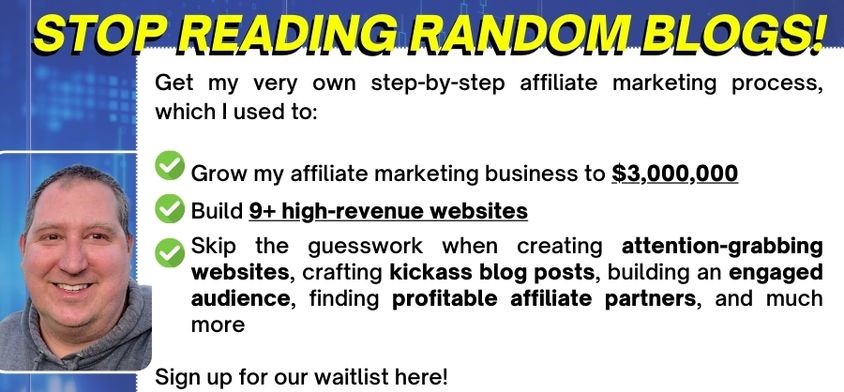Whether you’re new to affiliate marketing or have been involved with affiliate marketing for several years, it’s important to reassess where to place affiliate links on a website or blog every so often. As times change, so does the optimum placement of affiliate links. Just 10 years ago, nobody was walking around surfing the internet on tablets and smartphones. How quickly times have changed!
It isn’t just the technology changing, either, but the psychology behind gaining clicks on affiliate links also changes. Back in the late 1990’s (YES – affiliate marketing existed then!), it was common to see banner ads everywhere. Those quickly became less effective, so affiliate marketers began using pop-up’s. As those became less effective, they began using email marketing methods or social media or in-article text links. It’s always changing.
So, with that said, what is working right now? As a full time affiliate marketer, I am more than willing to share what I have learned to help save you some time.
Use Banner Advertisements Sparingly
There once was a time when you could slap together a cheap website with a whole bunch of affiliate banners on it, then promote it through paid advertising or even by using sneaky black hat SEO tactics to rank the site in Google. No matter where you got your traffic from, you could almost bet that a decent percentage of people would click on your affiliate links or pay-per-click (PPC) ads and make you some money. Those days are long gone and those types of sites are easily identified as spam.
But that’s not to say banner ads don’t work at all. You’ll notice a couple banner ads right here on this very website. The key is to make sure your banner ads are not spammy looking. Stay away from any flash or animated ads, those are like click repellant. Stay with very simple ads that quickly portray why they should click on the banner. For the most part, banner ads are going to have your lowest click-through-rate (CTR), but they are still worthy of some light implementation.
So, where are the best places to put banner ads on your site or blog? Research has shown that the best way to get clicks on banner ads is to get people who landed on a page and quickly see the ad. This is what we call “trigger happy” website visitors. They get to your page, see your banner ad within seconds, and already click on it before reading anything else on the site.
Now, in order to increase how many “trigger happy” people you can capture, you should put the banner ads in the areas people look first. In the vast majority of cases, website visitors will scan the top and left sides of the screen first. So, now that you know that, where do you think it’s best to place those banner ads? 😉
There is one main thing you need to be cautious about, however. In 2011, Google released an algorithm update called Panda, which began penalizing websites that had too many advertisements at the top of the website. While 1 or 2 is fine, make sure your website visitors are also able to see a lot of space that isn’t covered by advertisements. It looks spammy when you do that anyway.
Also, remember that a banner ad doesn’t have to be an ugly looking mess. I frequently embed the below “banner” into my articles all the time and it receives a pretty good CTR.
Set Up An Email Marketing Campaign Immediately
Email marketing is probably the cheapest form of advertising. When you build an email list, you get to advertise to a highly targeted audience over and over and over again. The trick is, you need to also provide real value to your email subscribers. Offer them some thing really awesome for free in exchange for their email address, and once you have their email address, don’t send them sales pitches everyday. Instead, you should send some truly helpful emails and every now and then, throw in a hard sales pitch. Just don’t get too aggressive because your email subscribers are like gold. Treat them well and keep the open rate high and the unsubscribe rate low!
Use Text Links With Your Affiliate Code
I personally see my highest CTR with text links embedded into articles. For example, I often recommend that new affiliate marketers sign up for this really good training program (psst… that’s an affiliate link).
Every article I write, I try to make it helpful for those who will read it. I hope, for example, that you are finding this article helpful and educational. When I do that, I am not only offering a free service for people, but I also gain their trust. When I gain their trust, they don’t think twice about clicking on a link to a recommended product or service. And since I’m truly providing quality content, I can bet that a very large number of people who read my articles will read the entire thing, or at least most of it. This has given me some incredible CTR’s on text links.
No doubt, the best friend for affiliate marketers is having a quality article with a few embedded affiliate links that brings in lots of free traffic from Google every day. Nothing can compete with that.
Avoid The Number One Mistake Made My New Affiliate Marketers
Many new affiliate marketers are under the impression they can simply sign up to be an affiliate somewhere, then go off and spam commenting sections or social media with their affiliate links and make money. Nothing could be further from the truth and spamming the internet just ruins a good thing for us all. It’s also unrealistic to think that a blog that receives 25 visitors per day has any chance at making money with some properly placed banner ads.
Affiliate marketing takes work. It’s a business and it takes time to get good enough at it to make money. The biggest mistake by most affiliate marketers is they don’t have the patience to stick it out.
As I posted above, the best placement for affiliate links is inside high quality articles that people actually want to read. Before you can expect your site to gain enough traffic to make that profitable, you need lots and lots of awesome content (100 full-length content pages minimum). Otherwise, you’ll need to pay for your website traffic through paid advertising and even that has quite the learning curve with a lot of expense.
The solution? Be patient, focus on a topic you love, and take the time to learn how to build a real website or blog that provides real value so that real people will be easily persuaded when you make a good product or service recommendation. That’s the only way to build a legitimate affiliate marketing business, no matter where you place your affiliate links.



